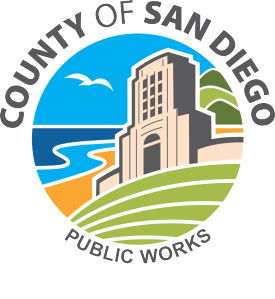Desert Roads
Desert Roads Paved With Past
By Tom Davis, Field Engineering
Montezuma Valley Road stands on its tail and slithers up the mountain from Borrego Springs to Ranchita. Borrego-Salton Sea Way, Yaqui Pass Road, and County Highway S-2 wind their way along the Anza-Borrego Desert floor. These important roads were built by San Diego County’s Road Department, now known as DPW’s Transportation Division.
In the first half of the last century, there were several prison camps in our backcountry, which provided much of the labor for road construction in the desert.
Each of these roads has an interesting history.

Yaqui Pass Road was the first improved road into Borrego valley. Construction from Julian Highway/Kane Spring Road, now Highway 78, was completed in 1934. During World War II, Yaqui Pass was used by the Marines to get to Camp Ensign, near Clark Dry Lake.
Borrego-Salton Sea Way got its name as the result of a coin toss. Both Borrego and Salton City Chambers of Commerce disliked the original name, Truckhaven Trail. In January 1968, Robert Cozens, Board of Supervisors chairman, suggested the name Borrego-Salton Sea Way. But the Salton City Chamber of Commerce preferred Salton-Borrego Sea Way. A flip of a coin settled the issue. "Seaway" was originally rejected because it implied a shipping route. Sea Way was preferred because it meant the route to the Salton Sea. According to Diana Lindsay, author of Anza-Borrego A-Z, the county sign painter in 1968 didn’t realize the difference, and made the street sign "Seaway." The error has never been corrected. Even today, the one-word "Seaway" still appears in the Road Register, Sign Index and on the Street Name Signs.
Until the grade into Borrego Valley was completed, Montezuma Valley Road stopped at "Verruga", later re-named Ranchita. Anyone wanting access to the valley at that time had to use Yaqui Pass Road many miles away. Construction of Montezuma Grade began in 1954 and took nearly 10 years to complete. Foremen Ben McManama and Carl Randall were often the only County employees on the job, supervising prisoners from Montezuma Honor Camp. In all, they used160,000 tons of dynamite to carve a way down San Ysidro Mountain. Gale Gordon, Honorary Mayor of Borrego Springs and star of television’s "The Lucy Show", declared June 24, 1964 a holiday in Borrego Springs to mark completion of the road. Today, Borrego Springs Road Crew Supervisor Dan McManama, Ben’s son, is responsible for maintaining the road his dad helped build.
Highway S-2 has several names: San Felipe Road, Great Overland Stage Route of 1849, Sweeney Pass, and Imperial Highway. Trumpeted by the El Centro Chamber of Commerce in the late 1920’s as a "Gateway to Imperial County", it followed much of the route of the Southern Emigrant Trail, which began during the Gold Rush of the 1850’s, and the old Butterfield Mail route, which began in 1851. The Imperial Highway Association, formed in 1929, urged the paving of the old Butterfield route. Imperial County did the first paving, from Ocotillo to the San Diego County line. From there to the bottom of Sweeney Pass, it was a set of meandering, sand-bound tracks. In 1951, County engineers designed and constructed the route along the hillsides and down the pass, but the road was still unpaved for several years. In 1953, a group of property owners lobbied the Board of Supervisors for road improvements, which finally came in 1959-61. The petitioners also asked for a name change, from Imperial Highway to the Great Overland Stage Route of 1849. The Supervisors agreed, despite the fact that the Overland Mail Route was never known as "Great," the route was not "Southern," and it didn’t exist in 1849.






